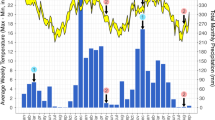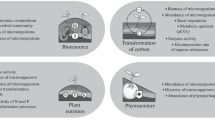Abstract
Samples from a sandy agricultural soil were treated with increasing amounts of a fungicide (Sportak). The effects on the soil microflora were investigated over several weeks by monitoring basal and substrate-induced respiration and basal and substrate-induced heat output. The microbial biomass, metabolic quotient (qCO2), relative heat output (rqheat), lag phase of substrate use, and calorimetric: respirometric ratio were used as ecophysiological parametèrs. As structural and community-specific parameters, we recorded tryptophan contents and auxin metabolism, and calculated the ratios of fungal to bacterial respiration by antibiotic inhibition of substrate-induced respiration. Sportak either inhibited or stimulated the microbiota, depending on the length of exposure to the fungicide and the amount applied. Mineralization of dead biomass was reflected in increased soil tryptophan contents after the Sportak application. A shortened lag phase demonstrated inhibition and a prolonged lag phase stimulation of substrate use. This changed with the experimental phase. The rqheat and the calorimetric: respirometric ratio proved to be suitable parameters for the detection of stress metabolism (repair processes) in soil microbiota, because thermodynamic processes and catabolic and anabolic metabolism are taken into account at the same time. Following the application of Sportak, indole 3-acetic acid biosynthesis decreased while indole-3-ethanol biosynthesis increased, probably as a result of a transitional community shift from K-strategists towards r-strategists. It was not the fungicide but the formulation (mainly xylol) that damaged the organisms. A shift in the ratio of fungi to bacteria was also observed, suggesting that the bacteria were probably more sensitive to xylol than the fungi.
Similar content being viewed by others
References
Anderson JPE, Domsch KH (1973) Quantification of bacterial and fungal contributions to soil respiration. Arch Microbiol 93:113–127
Anderson JPE, Domsch KH (1974) Use of selective inhibitors in the study of respiratory activities and shifts in bacterial and fungal populations in soil. Ann Microbiol 24:189–194
Anderson JPE, Domsch KH (1975) Measurement of bacterial and fungal contribution to respiration of selected agricultural and forest soils. Can J Microbiol 21:314–322
Anderson JPE, Domsch KH (1978) A physiological method for the quantitative measurement of microbial biomass in soils. Soil Biol Biochem 10:215–221
Anderson TH, Domsch KH (1986) Carbon assimilation and microbial activity in soil. Z Pflanzenernaer Bodenkd 149:457–468
Andrews JH, Harris RF (1986) r- and K-selection and microbial ecology. In: Marshall KC (ed) Advances in microbial ecology. Plenum Press, New York, pp 99–148
Bai QY, Zelles L, Scheunert I, Korte F (1989) Determination of adenine nucleotides in soil by ion-paired reverse-phase high-performance liquid chromatography. J Microbiol Methods 9:345–351
Bharathi C, Rao BVSSRS (1984) Effect of monocrotophos on the oxygen uptake of a tropical earthworm Lamipito mauritii (Kinb). J Curr Biosci 1:35–37
Criddle RS, Fontana AJ, Rank DR, Paige D, Hansen LD, Breidenbach RW (1991) Simultaneous measurement of metabolic heat rate, CO2 production, and O2 consumption by microcalorimetry. Anal Biochem 194:413–417
Domsch KH (1991) Status and perspectives of side-effect testing. Toxicol Environ Chem 30:147–152
Gnaiger E (1989) Physiological calorimetry: Heat flux, metabolic flux, entropy and power. Thermochim Acta 151:23–34
Hausner T-P, Nierhaus KH (1988) Proteinsynthese und ihre Hemmung durch Antibiotika. Biologie in unserer Zeit 5:129–144
Heilmann B (1993) Bestimmung der mikrobiellen Biomasse mittels Wärmeproduktion. In: Schinner F, Öhlinger R, Kandeler E, Margesin R (eds) Bodenbiologische Arbeitsmethoden, 2nd edn. Springer, Berlin Heidelberg New York, pp 73–79
Heilmann B, Beese F (1991) Variabilität der mikrobiellen Aktivität und Biomasse eines großen Bodenkollektivs in Abhängigkeit von verschiedenen Standortsparametern. Mitt Dtsch Bodenkd Ges 66:495–498
Heilmann B, Beese F (1992) Miniaturized method to measure carbon dioxide production and biomass of soil microorganisms. Soil Sci Soc Am J 56:596–598
Heinemeyer O, Insam H, Kaiser EA, Walenzik G (1989) Soil microbial biomass and respiration measurements: An automated technique based on infra-red gas analysis. Plant and Soil 116:191–195
Insam H, Haselwandter K (1989) Metabolic quotient of the soil microflora in relation to plant succession. Oecologia 79: 174–178
Kapteyn JC, Pillmoor JB, De Waard MA (1992) Biochemical mechanisms involved in selective fungitoxicity of two sterol 14α-demethylation inhibitors, prochloraz and quinconazole: Accumulation and metabolism studies. Pestic Sci 36:85–93
Kawabata T, Yamano H, Takahashi K (1983) An attempt to characterize calorimetrically the inhibitory effect of foreign substances on microbial degradation of glucose in soil. Agric Biol Chem 47:1281–1288
Lebuhn M, Hartmann A (1993) Method for the determination of indol-3-acetic acid and related compounds of L-tryptophan catabolism in soils. J Chromatogr 629:255–266
Lebuhn M, Heilmann B, Hartmann A (1994) Effects of drying/rewetting stress on microbial auxin production and L-tryptophan catabolism in soils. Biol Fert Soils 18:302–310
Lynch JM (1982) The rhizosphere. In: Burns RG, Slater JH (eds) Experimental microbial ecology. Blackwell Scientific Publications, Oxford London, pp 395–411
Morgan P, Cooper CJ, Battersby NS, Lee SA, Lewis ST, Machin TM, Graham SC, Watkinson RJ (1991) Automated image analysis method to determine fungal biomass in soils and on solid matrices. Soil Biol Biochem 23:609–616
Neely CL, Beare MH, Hargrove WL, Coleman DC (1991) Relationships between fungal and bacterial substrate-induced respiration, biomass and plant residue decomposition. Soil Biol Biochem 23:947–954
Nordmark MG, Laynez J, Schön A, Suurkuusk J, Wadsö I (1984) Design and testing of a new microcalorimetric vessel for use with living cellular systems and in titration experiments. J Biochem Biophys Methods 10:187–202
Odum EP (1969) The strategy of ecosystem development. Science 164:261–270
Parkinson D, Coleman DC (1991) Methods for assessing soil microbial populations, activity and biomass. Agric Ecosyst Environ 34:3–33
Pianka ER (1970) On r- and K-selection. Am Nat 104:592–597
Sand W (1987) Microcalorimetry. A modern method for solving biological problems. For Mikrobiol 6:220–223
Santruckova H, Straskraba M (1991) On the relationship between specific respiration activity and microbial biomass in soils. Soil Biol Biochem 23:525–532
Smith JL, Paul EA (1990) The significance of soil microbial biomass estimations. Soil Biochem 7:357–396
Sparling GP (1985) The soil biomass. In: Vaughan D, Malcolm RE (eds) Soil organic matter and biological activity. Nijhoff Junk, Dordrecht, pp 223–262
Vancura V, Kunc F (1977) The effect of streptomycin and actidione on respiration in the rhizosphere and non-rhizosphere soil. Zentralbl Bakteriol Parasitenkd Infektionskr Hyg Abt 2 132: 472–478
Vandhove H, de Coninck K, Coorvits R, Merckx R, Vlassak K (1991) Microcalorimetry as a tool to detect changes in soil microbial biomass. Toxicol Environ Chem 30:202–206
Visser S, Parkinson D (1989) Microbial respiration and biomass in a soil of a lodgepole pine stand acidified with elemental sulphur. Can J For Res 19:955–969
Wardle DA, Parkinson D (1990) Response of the soil microbial biomass to glucose, and selective inhibitors, across a soil moisture gradient. Soil Biol Biochem 22:825–834
West AW (1986) Improvement of the selective respiratory inhibition technique to measure eukaryote: prokaryote ratios in soils. J Microbiol Methods 5:125–138
West AW, Sparling GP, Grant WD (1987) Relationships between mycelial and bacterial populations in stored, air-dried and glucose-amended arable and grassland soils. Soil Biol Biochem 19:599–605
Wieser W (1986) Bioenergetik. Thieme, Stuttgart
Zelles L, Scheunert I, Korte F (1986) Comparison of methods to test chemicals for side effects on soil microorganism. Ecotoxicol Environ Safety 12:53–69
Author information
Authors and Affiliations
Rights and permissions
About this article
Cite this article
Heilmann, B., Lebuhn, M. & Beese, F. Methods for the investigation of metabolic activities and shifts in the microbial community in a soil treated with a fungicide. Biol Fertil Soils 19, 186–192 (1995). https://doi.org/10.1007/BF00336157
Received:
Issue Date:
DOI: https://doi.org/10.1007/BF00336157




